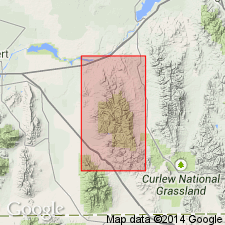
- Usage in publication:
-
- Tussing Sandstone
- Modifications:
-
- Named
- Dominant lithology:
-
- Sandstone
- Quartzite
- Limestone
- AAPG geologic province:
-
- Snake River basin
Summary:
Named for exposures along ridge between Tussing Canyon and Alney Canyon, Sublett Range in SE1/4 sec 13 and NE1/4 sec 22, T12S, R30E (the type section), Snake River basin, Power Co, ID where it is 2,600 ft thick. Extends into Oneida Co, ID in Great Basin province. Is a sandstone and calcareous quartzite with interbedded (but subordinate) limestone. Chert is common in upper part. Is mostly tan, brown, and gray. Underlies Trail Canyon Limestone (new name); lower contact not known. Is unfossiliferous; age assignment (minimum) of Early Permian or Wolfcampian determined from age of overlying Trail Canyon which has Leonardian fossils. Type section measured. Graphic sections.
Source: GNU records (USGS DDS-6; Denver GNULEX).

- Usage in publication:
-
- Tussing Formation
- Modifications:
-
- Revised
- Redescribed
- AAPG geologic province:
-
- Great Basin province
Summary:
Assigned as a formation (1 of 5) of the Oquirrh Group. Term Tussing Formation rather than Tussing Sandstone used. Formation about 1300 m thick consists mostly of sandstone but has sandy limestone and siltstone. The sandstone may be calcareous to noncalcareous. Divisible into an upper unit that corresponds to the original Tussing as named by Cramer in 1971 and a lower unit that corresponds to the part added to the Tussing by Armstrong and others in 1978. The lower unit belongs lithologically more with Tussing rocks than with the underlying Heglar Canyon Formation of Oquirrh Group (also newly assigned to Oquirrh). A 10 m thick gradational zone of tan limestone and thick-bedded limestone separates Heglar Canyon from Tussing. Contact placed at top of highest thick limestone; gradational zone placed in Heglar Canyon. Underlies Trail Canyon Formation of Oquirrh (newly assigned to Oquirrh). Tussing-Trail Canyon contact placed at change from predominantly sandstone to predominantly limestone. Fossils scarce. Age of lower unit is Middle Pennsylvanian (Desmoinesian). Age of upper unit is Middle Pennsylvanian, Desmoinesian and Late Pennsylvanian, Missourian. Nomenclature chart. Columnar section. Geologic map. Term Sublett Member of Wells Formation formerly assigned to Tussing of this report; Sublett abandoned; Wells not used.
Source: GNU records (USGS DDS-6; Denver GNULEX).
For more information, please contact Nancy Stamm, Geologic Names Committee Secretary.
Asterisk (*) indicates published by U.S. Geological Survey authors.
"No current usage" (†) implies that a name has been abandoned or has fallen into disuse. Former usage and, if known, replacement name given in parentheses ( ).
Slash (/) indicates name conflicts with nomenclatural guidelines (CSN, 1933; ACSN, 1961, 1970; NACSN, 1983, 2005, 2021). May be explained within brackets ([ ]).

